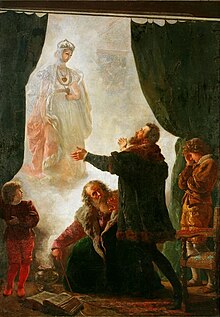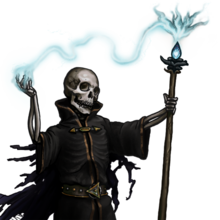Undead: Difference between revisions
Delete same picture |
the Reference edits |
||
| Line 5: | Line 5: | ||
The '''undead''' are those beings that are deceased and yet behave as if alive. The term ''undead'' could also describe a dead body animated by supernatural forces (or some other [[Energy (esotericism)|life force]]) or by either its own [[soul]] or the soul of a malevolent creature (such as a [[demon]]). Undead may be [[Incorporeality|incorporeal]], such as [[ghost]]s, or [[Body|corporeal]], such as [[vampire]]s and [[zombie]]s. The ''undead'' are featured in the [[legend]]s of most cultures and in many works of [[fantasy fiction|fantasy]] and [[horror fiction]]. |
The '''undead''' are those beings that are deceased and yet behave as if alive. The term ''undead'' could also describe a dead body animated by supernatural forces (or some other [[Energy (esotericism)|life force]]) or by either its own [[soul]] or the soul of a malevolent creature (such as a [[demon]]). Undead may be [[Incorporeality|incorporeal]], such as [[ghost]]s, or [[Body|corporeal]], such as [[vampire]]s and [[zombie]]s. The ''undead'' are featured in the [[legend]]s of most cultures and in many works of [[fantasy fiction|fantasy]] and [[horror fiction]]. |
||
[[Bram Stoker]] considered the name ''The Un-Dead'' as the original title for his novel ''[[Dracula]]'' (1897), and its use in the novel is mostly responsible for the modern sense of the word. The word does appear in English before Stoker but with the more literal sense of "alive" or "not dead", for which citations can be found in the ''[[Oxford English Dictionary]]''. Stoker's use of the term refers only to [[vampires]], and the extension to other types of supernatural beings arose later. Most commonly, it is now taken to refer to supernatural beings which had at one time been alive and continue to display some aspects of life after death, but the usage is highly variable. |
[[Bram Stoker]] considered the name ''The Un-Dead'' as the original title for his novel ''[[Dracula]]'' (1897), and its use in the novel is mostly responsible for the modern sense of the word. The word does appear in English before Stoker but with the more literal sense of "alive" or "not dead", for which citations can be found in the ''[[Oxford English Dictionary]]''. Stoker's use of the term refers only to [[vampires]], and the extension to other types of supernatural beings arose later. Most commonly, it is now taken to refer to supernatural beings which had at one time been alive and continue to display some aspects of life after death, but the usage is highly variable.<ref>{{cite web|url=http://etext.virginia.edu/etcbin/toccer-new2?id=BieCans.sgm&images=images/modeng&data=/texts/english/modeng/parsed&tag=public&part=1&division=div1 |title=Can Such Things Be |publisher=Etext.virginia.edu |date= |accessdate=2012-07-31}}</ref> |
||
==Literature== |
==Literature== |
||
Revision as of 18:31, 1 August 2012

The undead are those beings that are deceased and yet behave as if alive. The term undead could also describe a dead body animated by supernatural forces (or some other life force) or by either its own soul or the soul of a malevolent creature (such as a demon). Undead may be incorporeal, such as ghosts, or corporeal, such as vampires and zombies. The undead are featured in the legends of most cultures and in many works of fantasy and horror fiction.
Bram Stoker considered the name The Un-Dead as the original title for his novel Dracula (1897), and its use in the novel is mostly responsible for the modern sense of the word. The word does appear in English before Stoker but with the more literal sense of "alive" or "not dead", for which citations can be found in the Oxford English Dictionary. Stoker's use of the term refers only to vampires, and the extension to other types of supernatural beings arose later. Most commonly, it is now taken to refer to supernatural beings which had at one time been alive and continue to display some aspects of life after death, but the usage is highly variable.[1]
Literature
Frankenstein by Mary Shelley is a seminal text in 19th century discourse about the undead. Published in 1818, it was based on a number of sources, including Ovid's myth of Prometheus (indeed, the novel is subtitled "The Modern Prometheus"), Milton's Paradise Lost, Coleridge's The Rime of the Ancient Mariner, and William Beckford's Gothic novel Vathek. Shelley also drew on European folklore,[2] such as the medieval Jewish legend of the golem, and German, Czech and Moravian ghost stories featuring vengeful dead (many of whom have characteristics of vampires rather than zombies).
Later notable 19th century stories about the avenging undead included Ambrose Bierce's The Death of Halpin Frayser,[3] and various Gothic Romanticism tales by Edgar Allan Poe. Though their works could not be properly considered zombie fiction, the supernatural tales of Bierce and Poe would prove influential on later writers such as H. P. Lovecraft, by Lovecraft's own admission.[4]

19th Century
Frankenstein by Mary Shelley is a seminal text in 19th century discourse about the undead. Published in 1818, it was based on a number of sources, including Ovid's myth of Prometheus (indeed, the novel is subtitled "The Modern Prometheus"), Milton's Paradise Lost, Coleridge's The Rime of the Ancient Mariner, and William Beckford's Gothic novel Vathek. Shelley also drew on European folklore,[5] such as the medieval Jewish legend of the golem, and German, Czech and Moravian ghost stories featuring vengeful dead (many of whom have characteristics of vampires rather than zombies).
Later notable 19th century stories about the avenging undead included Ambrose Bierce's The Death of Halpin Frayser,[6] and various Gothic Romanticism tales by Edgar Allan Poe. Though their works could not be properly considered zombie fiction, the supernatural tales of Bierce and Poe would prove influential on later writers such as H. P. Lovecraft, by Lovecraft's own admission.[7]
Creation
Both legend and popular culture discuss various methods for creating undead creatures. Most involve the reanimation of a corpse, as with zombies, skeletons, and ghouls. Regarding ghosts, the spirit lives on after death, forming an intangible physical body that often mirrors the one the spirit had in life. Rituals propitiating the uneasy spirits of the dead were a feature of ancient Greek religion (keres), ancient Roman religion (lemures), and Hinduism.
In some cases, the undead, especially skeletons and zombies, are under the control of a necromancer. In other cases, such as zombies as depicted in film, the undead existence is passed on like a curse or disease. Ghosts are said to be kept in their undead state by willpower, either from a keen desire to remain with the living or from a wish to see something completed that they could not do during their lifetime. Revenants are a corporeal analog for ghosts in this manner, their independence setting them apart from the typically mindless skeleton or zombie.
Forms of undead
- Living corpses
- Spirits
Fiction and films

Many films have been made about the undead, usually ghosts, zombies, vampires and mummies, including such fiction as Dracula, Grave Encounters, Shutter, The Grudge, The Crow, Friday the 13th (franchise), Night of the Living Dead, and The Mummy.
Games and popular culture

Undead are a popular adversary in fantasy and horror settings. They feature prominently in many role-playing games, role-playing video games, MMORPGs and strategy games. In such games, special rules are often given for the undead.
In Dungeons & Dragons and similar systems, clerics can attempt to "turn" undead by invoking their patron deities or channeling "positive energy" (other-dimensional life energy, which animates and heals living creatures, and is the antithesis of negative energy, which animates and heals undead creatures.) This forces the undead creature away from the cleric; powerful clerics are capable of completely destroying weaker undead creatures with this ability. Although the act of turning away the undead relies primarily on power of faith, a holy symbol is usually required as a focus for the divine power being invoked. Clerics of evil gods can rebuke and control the undead in a similar fashion.[8]
In other games Final Fantasy, undead can be damaged by using magical effects that heal normal living beings.[9]
In videogame settings such as Poxnora and World of Warcraft undead NPC's or players gain advantages that come with the undead state, such as immunity to Fear mechanics, Mind Control, Bleeding, Disease, Poison and a variety of other effects, be it physical or mental, that do not apply to creatures with no living flesh, blood or a conscious state of mind.
Undead characters appear in many roles, be it a mindless horde of opponents (such as zombies or skeletons) or a thoughtful, plotting villain. Some games feature undead playable characters, such as Vampire: The Masquerade and World of Warcraft. Others, such as Diablo 2, allow the player to take on the role of a necromancer and raise undead from corpses.
In science
The concept of undeath is not known to science. The capacity for dead matter to behave as though it were alive has not been demonstrated to be scientifically plausible and, hence, remains a concept of fiction. The terminology of undeath is occasionally used colloquially to refer to the victims of parasitoid animals.
See also
References
- ^ "Can Such Things Be". Etext.virginia.edu. Retrieved 2012-07-31.
- ^ Warner, Marina. A forgotten gem: Das Gespensterbuch ('The Book of Ghosts'), An Introduction book review
- ^ "Can Such Things Be". Etext.virginia.edu. Retrieved 2012-07-31.
- ^ "SUPERNATURAL HORROR IN LITERATURE (1927, 1933 - 1935) by H.P. Lovecraft". Gaslight.mtroyal.ca. 1988-01-01. Retrieved 2012-07-31.
- ^ Warner, Marina. A forgotten gem: Das Gespensterbuch ('The Book of Ghosts'), An Introduction book review
- ^ etext.virginia.edu
- ^ H. P. Lovecraft, Supernatural Horror in Literature (1927, 1933–1935), gaslight.mtroyal.ca
- ^ "Special Attacks: Turn Or Rebuke Undead". Retrieved 2006-05-11.
- ^ "Spells: Cure Light Wounds". Retrieved 2006-05-21.

